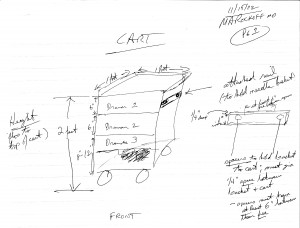All Mark Rockoff, MD, wanted was an operating room cart that could safely transport and discard the needles and tubes he inserted before surgery.
“Ever since I was a resident, there has been this inefficient system in every operating room for putting catheters into patients,” says Rockoff, Associate Anesthesiologist-in-Chief at Children’s Hospital Boston. The needles and supplies were individually carried to each patient’s bedside, used to set up the lines for IV fluids and medications and arterial monitoring, then carried away again for proper disposal. The patient’s bed served as a temporary work surface for the equipment.
Eight years ago, Rockoff futilely searched for a mobile work station among hundreds of exhibitors at the American Society of Anesthesiologists annual meeting. Frustrated, he spent the flight home sketching out his vision of the cart he wanted.
Next month marks the debut of the Start Cart, which Rockoff invented and perfected for use in Children’s operating rooms, where he’s worked for the past 30 years. The cart consolidates the supplies and disposal containers, and can be wheeled to each patient’s bed or operating table, offering a safer and more efficient system for handling needles and catheters. It features an adjustable worktop and attached needle disposal bin.
“You don’t have to be a genius to figure out the little things that can improve patient care,” said Rockoff.
Rockoff’s invention story was showcased last week at a Grand Rounds talk on clinical innovation at Children’s. Speakers highlighted efforts at the hospital to bridge the gap between concept and product, including new funding initiatives.
Meaningful improvements in patient care needn’t be elaborate, but they take persistence and dedication, said Stephen Corn, MD, director of clinical innovation for Children’s and Brigham & Women’s Hospital anesthesiology departments. Corn is a prolific inventor who holds 30 patents, including several technologies licensed through Children’s. (The Boston Business Journal named Corn a health care champion in clinical innovation.)
“Some of the best ideas for improvement come from persons who are involved in patient care on a daily basis,” says Corn, who helped Rockoff license his invention through Children’s. “Individual clinicians frequently find gaps in the technology, or areas in which state-of-the-art care seems to fall short in some way. Many clinicians think of clever, innovative solutions to fill such gaps, but few of them know how to proceed to develop their ideas into licensed products for clinical care.”
Within an organization, the hardest part comes after the prototype or pilot stage, said Naomi Fried, PhD, who joined Children’s in June as the hospital’s first chief innovation officer. “For the innovator who has proven something has worked, it’s a challenge to get it out there as a successful deployment,” she said.
Greater challenges loom in the bigger marketplace. “We now have to advance the stage of the development of our innovations before a company is interested,” said Erik Halvorsen, PhD, director of Children’s Technology & Innovation Development Office (TIDO).
To advance promising technologies, TIDO awards $1 million a year, with most of the funds going to contract research organizations for services such as preclinical toxicity testing and formulating analogs of active compounds. An advisory panel of industry leaders in devices, diagnostics and therapeutics makes key judgments in how to spend the money to advance the technologies to market.
To date, Children’s has 10 major medical products on the market, including Revlimid, the angiogenesis inhibitor sold by Celgene, and Namenda for Alzheimer’s disease from Merz Pharmaceuticals. Several more products are in clinical trials.
Corn’s latest clinical innovation reading list:
Gene Patenting — Is the Pendulum Swinging Back? New England Journal of Medicine, May 20, 2010 (subscription needed)
Serving Two Masters — Conflicts of Interest in Academic Medicine, New England Journal of Medicine, Feb. 25, 2010.
Disclosure of Financial Relationship to Participants in Clinical Research, New England Journal of Medicine, Aug. 27, 2009.
The Medical Device Safety Act of 2009, New England Journal of Medicine, April 9, 2009.
Shifting Terrain in the Regulation of Off-Label Promotion of Pharmaceuticals, New England Journal of Medicine, April 9, 2009 (subscription needed).
The Supreme Court, Preemption, and Malpractice Liability, New England Journal of Medicine, Feb. 5, 2009
Pharmaceutical Promotion to Physicians and First Amendment Rights, April 17, 2008 (subscription needed).
Regulating Off-Label Drug Use — Rethinking the Role of the FDA New England Journal of Medicine, April 3, 2008.
The Anatomy of Medical School Patenting, New England Journal of Medicine, Nov. 15, 2007.








